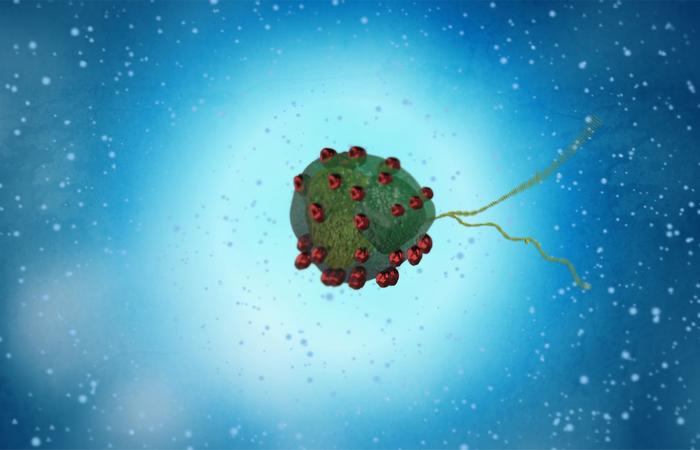In a remarkable breakthrough that merges the complexities of biomedicine and robotics, a team of researchers from the Max Planck Institute for Intelligent Systems (MPI-IS) in Stuttgart has developed a revolutionary biohybrid micro swimmer that showcases a profound leap in the capabilities of microscopic movement. With the aid of a thin coating of magnetic material, this innovation retains the remarkable swimming ability of microalgae, allowing for exciting potential applications in targeted drug delivery and other medical fields.
Microalgae, measuring just ten microns and naturally skilled in swimming through their aquatic environments, owe their locomotion to the action of their whip-like flagella. These tiny organisms propel themselves efficiently in fluid environments, dominating their microcosmic domain. The researchers posed a fascinating question: How would the functionality of these agile swimmers be impacted if scientists were to envelop them in a bespoke coating of chitosan— a natural polymer—augmented with magnetic nanoparticles?
The team’s investigations revealed surprising findings. Despite the additional weight carried by the microalgal swimmers due to the magnetic coating, their ability to navigate through tight spaces and viscous liquids remained largely unaltered. Under their natural propulsion method, reminiscent of human breast-stroking, the algae moved with impressive swiftness, achieving an average swimming speed of 115 micrometers per second, which scales to approximately twelve body lengths per second. To put this into perspective, this speed far surpasses that of elite human swimmers like Michael Phelps, who manages only 1.4 body lengths per second.
This pioneering research, spearheaded by scientists Birgül Akolpoglu and Saadet Fatma Baltaci, who co-led the study, indicates that microalgae can be re-envisioned as efficient microrobots. The impetus behind this transformation arose from a desire to control the movement of these unicellular organisms magnetically, essentially steering them towards designated targets. Such advancements could lead to the development of sophisticated microrobots capable of performing targeted interventions within biological systems.
The process of coating these microalgae was not only rapid—taking just minutes—but also remarkably successful, with approximately ninety percent of the swimmers effectively covered in the proposed coating. Initial tests conducted by the researchers characterized the micro swimmers’ movements in a fluid environment closely resembling water. Using external magnetic fields, they demonstrated their ability to manipulate the swimming direction, leading to smooth navigation under the influence of magnetic forces.
Tests progressed as the researchers developed intricate 3D-printed cylinders to create a confined discursive environment wherein navigation could be studied. Each microchannel created limited dimensions only three times the size of the algal swimmers, posing a unique challenge. To maximize control and confirm effective steering, the team integrated two distinct magnetic systems: one using magnetic coils and another involving permanent magnets strategically surrounding their microscopic observations.
Findings emphasized that, while navigating without any magnetic guidance, microalgal swimmers often encountered obstacles, resulting in frequent backtracking. However, the implementation of magnetic manipulation significantly improved movement efficiency, allowing the biohybrid to glide smoothly and avoid impasses, much akin to the way navigation systems function in larger scale robotics. This breakthrough indicates remarkable potential not only for improved maneuverability in microenvironments but also for future applications in medical technologies.
As the study proceeded, the researchers sought to simulate a more challenging environment by increasing the viscosity of the fluid through which their microswimmers traversed. The aim was to replicate conditions similar to those found in human bodily mucus, to observe how these biohybrids could respond under heightened resistance. Results indicated a greater impact of viscosity on their swimming patterns, as higher levels caused the algae to oscillate and adopt a zigzag trajectory. This finding suggests an important interplay between fluid dynamics and magnetic guidance, opening avenues for future enhancements in microrobot navigation.
The ultimate vision for this research extends beyond the confines of the laboratory into real-world applications. The capacity to integrate biohybrids into small, complex environments, particularly those mimicking human tissues, could signal a revolution in drug delivery systems. The implications of these findings resonate with potential breakthroughs in biomedicine, creating pathways for intelligent medical treatments that leverage biological harmony with innovative engineering.
These microrobots could be harnessed to deliver therapeutic agents directly to targeted areas within the body, minimizing side effects while enhancing the effectiveness of treatment regimens. This capability highlights the critical importance of adapting technologies to work seamlessly within biological frameworks, thereby offering biocompatible solutions that cater to the innate complexities of human anatomy.
As researchers dive deeper into the mysteries of microrobot capabilities, this pioneering research lays down a robust foundation for future explorations. While the study addresses fundamental mechanics of swimming and navigation at a microscopic scale, its broad implications create a tantalizing prospect for schools of thought that converge various fields of science and engineering. The exceptional potential of these algae-based robots presents an intriguing narrative for the future of personalized medicine, biotechnology, and environmental applications.
Through meticulous engineering and innovative thinking, scientists challenge traditional constraints of what is possible in the realm of biotechnology. With every advancement, researchers illuminate the path toward a future where biohybrids could seamlessly operate as autonomous agents in our bodies, effectively partnering biology with technology in extraordinary ways. As the application of these findings unfolds, the landscape of both biomedical and engineering disciplines stands to undergo remarkable transformations, heralding an exciting new era of discovery and implementation.
In summary, the MPI-IS team’s work with magnetic biohybrids reconceptualizes microalgae not merely as organisms confined to their natural habitats but as dynamic entities with the potential to revolutionize how we understand and interact with both biological systems and technological advancements.
Subject of Research: Cells
Article Title: Navigating microalgal biohybrids through confinements with magnetic guidance
News Publication Date: 17-Mar-2025
Web References: DOI
References: Akolpoglu et al., Navigating microalgal biohybrids through confinements with magnetic guidance, Matter (2025)
Image Credits: Credit: MPI-IS / A. Posada
Keywords
Microrobots, Microalgae, Fluid viscosity, Robotics, Biomaterials, Biomimetics, Robotic locomotion, Medical robots, Engineering, Plant sciences.
Tags: advanced medical roboticsaquatic microorganisms in medicinebiohybrid micro swimmerschitosan-coated microalgaeefficient fluid navigationmagnetic microalgae technologymagnetic nanoparticles applicationsMax Planck Institute research breakthroughsmicroalgae locomotion researchmicroscopic movement innovationsrobotics in biomedicinetargeted drug delivery systems





